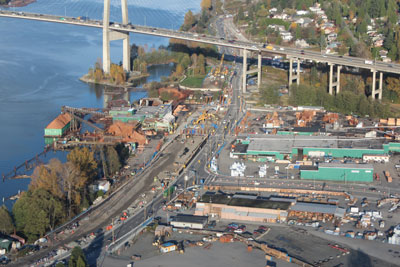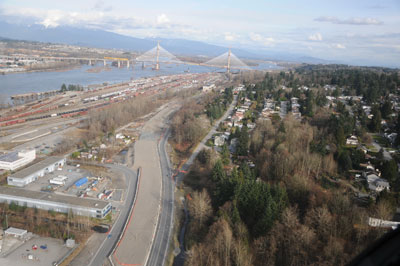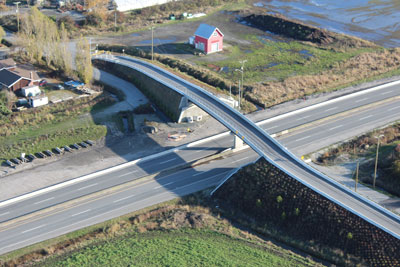
Features
Projects
Roads & Paving
Expanding Deltaport
New roads and overpasses being built in West Coast container terminal upgrade.
February 12, 2013 By Peter Caulfield
In addition to being responsible for waterborne traffic, Port Metro
Vancouver, Canada’s largest and busiest port, also looks after
infrastructure – road and rail infrastructure, to be specific.
In addition to being responsible for waterborne traffic, Port Metro Vancouver, Canada’s largest and busiest port, also looks after infrastructure – road and rail infrastructure, to be specific.
 |
|
| Construction work continues on the South Fraser Perimeter Road under the Alex Fraser bridge northeast of Delta.
|
For example, as part of its Container Capacity Improvement Program, Port Metro Vancouver (PMV) is upgrading infrastructure at its Deltaport container terminal with its Deltaport Terminal, Road and Rail Improvement Project (DTRRIP).
Located at Roberts Bank, 30 kilometres south of Vancouver on the U.S. border, Deltaport is the largest container terminal in Canada. When completed, the upgrade will increase Deltaport’s container capacity by 600,000 TEUs, from 1.8 million TEUs to 2.4 million TEUs (twenty-foot equivalent unit, a capacity measure in container transportation).
DTRRIP, which is in the detailed design stage, has four elements related to rail and road: Reconfiguration of rail track and additional container handling equipment in the existing Deltaport terminal; additional rail track in the existing railway corridor and a portion of adjacent land; an overpass on the existing Roberts Bank causeway, which extends from the port and the mainland, that will separate road and rail traffic; and road improvements on Deltaport Way to improve the movement of container trucks at Deltaport.
Port Metro Vancouver is not undertaking all of the project by itself. The port is working with the Province of British Columbia and TSI Terminal Systems Inc., the operator of Deltaport, on the project. PMV is doing the co-ordination and is responsible for project design, staging and scheduling. It is working with the provincial government on the road and rail improvements outside the Deltaport Terminal gate, and TSI Terminal Systems Inc. is taking care of those parts of the project that are within the terminal itself.
 |
|
| The South Fraser Perimeter Road links up with the Port Mann Bridge just north of Surrey.
|
Just like Greater Vancouver, PMV is large and sprawling and difficult to picture in the mind’s eye. Located on the southwest coast of British Columbia, it covers more than 600 kilometres of shoreline and extends from Point Roberts northward to Burrard Inlet (where the city of Vancouver is located) and eastward into the Fraser Valley.
PMV is much more than ships sailing majestically underneath the Lions Gate Bridge with snow-capped mountains in the background.
PMV has four container terminals. Container traffic in the port is busy and getting busier all the time. It set an all-time shipping record in 2010, when it moved 2.5 million TEUs. According to the port’s forecasts, container traffic is expected to double over the next 10 to 15 years and nearly triple by 2030.
The Container Capacity Improvement Program is PMV’s long-term, ongoing strategy to upgrade container capacity with new infrastructure and improvements to existing infrastructure. DTRRIP is the next in a series of improvements to its existing terminals.
In addition to the Deltaport project, PMV is working with other jurisdictions in the region to mitigate the effects of port growth on some communities. Two projects are underway to relieve road and rail congestion and to accommodate traffic generated by capacity increases at Roberts Bank: The South Fraser Perimeter Road and the Roberts Bank Rail Corridor Program.
The Province’s South Fraser Perimeter Road (SFPR) is a 40-kilometre, four-lane route along the south side of the Fraser River from Deltaport Way, in the southwest corner of Delta (a Vancouver suburb), eastward to 176th Street in Surrey (another suburb), with connections to Highways 1, 15, 17, 91, 99 and the Golden Ears Bridge, which crosses the Fraser River in the Fraser Valley. When completed, SFPR will become the main road south of the river.
In addition to shaving many minutes off commuter travel time, SFPR will divert truck and other traffic off congested municipal roads in Delta and Surrey.
The first phase of the project, from Highway 1 and 176th Street to 136th Street, was opened in December 2012.
The second phase, from 136th Street to Deltaport Way, is slated for completion in December 2013. When SFPR is finished, container trucks leaving Deltaport will be routed onto the new highway, removing them from sections of Highway 17 and Highway 91.
The Roberts Bank Rail Corridor Program is made up of one road network improvement project and eight road overpasses in the southern and eastern Vancouver suburbs of Delta, Surrey, the City of Langley and the Township of Langley.
 |
|
| Work has been completed on the 28th avenue agricultural bypass over Highway 17, located a few kilometres away from the Tsawwassen Ferry Terminal.
|
The Roberts Bank Rail Corridor consists mostly of single-rail track and carries up to 18 trains per day. Since they are coming from and going to the port, the trains are very long; some are almost two miles in length. By 2021, the volume of train traffic is expected to increase to 28-38 trains per day, and some of the trains are expected to be up to 12,000 feet long.
The corridor has 66 road-rail crossings. Of these, 12 are overpasses, 38 are public street-level crossings and 16 are private street-level crossings. Currently, about 388,000 vehicles per day cross the tracks. By 2021, that number is expected to increase to 560,000 vehicles per day.
With the expected increases in train and vehicle traffic, the existing network of street-level rail crossings is a challenge to the efficiency of both rail operation and the road network in the surrounding communities. Hence the Roberts Bank Rail Corridor Program.
Because the beneficiaries of the projects are many and interconnected, the projects are being funded by a collaboration of 12 partners, including local, regional, provincial and federal governments, and private industry. Port Metro Vancouver and its tenants and stakeholders are contributing $50 million.
The overpasses will separate road and rail traffic, with the intention of improving safety, easing community connections and minimizing the number of hooty train whistles. They are also expected to improve the efficiency of rail operations and the port.
All nine projects are underway, and will be complete by 2014, in advance of additional container movements to and from Deltaport.
Print this page